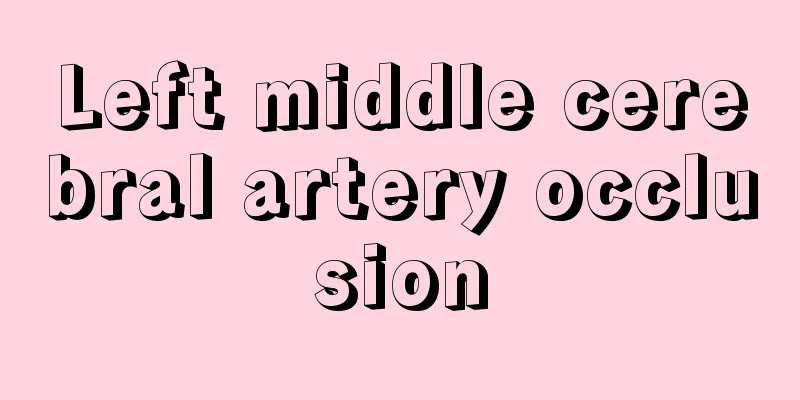Left middle cerebral artery occlusion

|
Everyone has a left brain and a right brain. Most of us have a more developed left brain than a right brain. This can be judged by the movements of our left and right hands. The left brain nerves are also very important to us. They generally manage our taste, vision, etc. If the left brain nerves are blocked, it will cause facial paralysis. So what should we do if the left cerebral artery is blocked? Main symptoms Main trunk occlusion leads to central facial and tongue paralysis and hemiplegia (basically equal), hemisensory disturbance and hemianopsia (triple hemiplegia) on the contralateral side of the lesion; the dominant hemisphere is affected and complete aphasia occurs, while the non-dominant hemisphere has body image disturbance. Cortical branch occlusion: (1) Upper branch stroke: including orbitofrontal, frontal, precentral gyrus and anterior parietal branches, resulting in mild hemiparesis and sensory loss of the face, hands and upper limbs, without involvement of the lower limbs, accompanied by Broca aphasia (dominant hemisphere) and body image disturbance (non-dominant hemisphere), without homonymous hemianopsia; (2) Lower branch stroke: including the temporal pole, temporo-occipital, and anterior, middle, and posterior branches of the temporal lobe. It rarely occurs alone, resulting in contralateral homonymous hemianopsia and severe damage to the lower visual field. The contralateral cortical sensations such as pattern perception and entity discrimination are significantly impaired, with pathological anesthesia, dressing apraxia, and structural apraxia, but no hemiplegia. The dominant hemisphere is affected, resulting in Wernicke aphasia, and the non-dominant hemisphere develops an acute state of confusion. Occlusion of deep perforators results in subcortical aphasia in the lesion. Causes of Disease The blood clot caused occlusion of the middle cerebral artery. Diagnostic tests Testing 1. Neuroimaging examination CT examinations should be performed routinely. In most cases, low-density infarction foci gradually appear 24 hours after onset. Uniform, sheet-like or wedge-shaped obvious low-density foci can be seen 2-15 days after onset. Large-area cerebral infarction is accompanied by cerebral edema and space-occupying effect, and hemorrhagic infarction presents mixed density. Attention should be paid to the infarction absorption period 2-3 weeks after the onset of the disease. The edema of the lesions disappears and the infiltration of phagocytes can be the same density as the brain tissue, which is difficult to distinguish on CT, and is called the "fuzzy effect." Enhanced scanning is of diagnostic significance. Enhancement occurs 5-6 days after infarction and is most obvious 1-2 weeks later. About 90% of infarct foci show uneven lesion tissue. However, sometimes CT cannot show smaller infarct lesions in the brainstem and cerebellum. MRI can clearly show early ischemic infarction, brainstem and cerebellar infarction, venous sinus thrombosis, etc. T1 low signal and T2 high signal foci appear several hours after infarction, and hemorrhagic infarction shows mixed T1 high signal. Gadolinium-enhanced MRI is more sensitive than plain scan. Functional MRI diffusion-weighted imaging (DWI) can diagnose ischemic stroke early and show ischemic lesions within 2 hours of onset, providing important information for early treatment. DSA can detect areas of vascular stenosis and occlusion, and show arteritis, Moyamoya disease, aneurysms and venous malformations, etc. 2. Lumbar puncture is only performed when CT examination is not possible and it is difficult to distinguish cerebral infarction from cerebral hemorrhage clinically. Usually, intracranial pressure and CSF are normal. Transcranial Doppler (TCD) can detect stenosis, atherosclerotic plaques or thrombosis of the carotid artery and internal carotid artery. Echocardiography can reveal cardiac mural thrombi, atrial myxoma, and mitral valve prolapse. |
<<: Is cerebral hemorrhage serious?
>>: How to treat hydrocephalus
Recommend
What are the symptoms of advanced lung cancer? If there are 3 symptoms of lung cancer, it means it is in the advanced stage
Many diseases often have no obvious symptoms in t...
Does diatom mud contain formaldehyde?
Many people are familiar with diatom mud. General...
How long can a person with hepatic encephalopathy usually live
If a brain disease like hepatic encephalopathy is...
If your palms feel numb, beware of four types of patients
In daily life, many people have experienced numbn...
What to do about the sequelae of heart bypass surgery
In the last century, people often died of heart d...
What causes right shoulder pain?
Many people have experienced right shoulder pain,...
Symptoms of heat stroke in spring
Heat stroke usually occurs in summer. But recentl...
Hainan specialty fruits
Everyone knows that there are many fruits in Hain...
What is the commonly mentioned Hepatitis B virus?
We often hear about hepatitis B virus (HBV) in ou...
Is germanium harmful to the human body?
Germanium is actually a chemical element. This su...
What should I do if my throat is inflamed
In addition to taking some medicines, it is actua...
Wearing flip-flops for a long time in summer will hurt your legs and feet
In summer, many people like to wear flip-flops, t...
Will drinking whole grains powder make you fat?
Whole grains powder is deeply loved by people in d...
Outdoor barbecue material list
With the quickening pace of life, people are unde...
What are the symptoms of pericoronitis of wisdom teeth?
The growth cycle of wisdom teeth is very slow. So...









